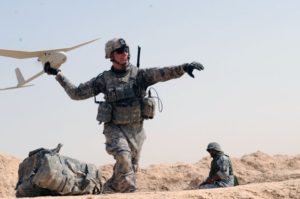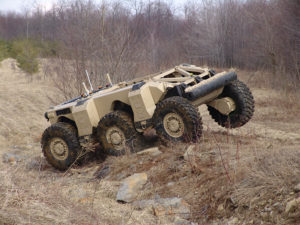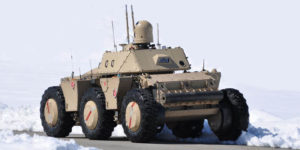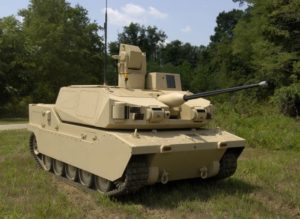
In response to the news that the US DoD will double its planned expenditure for wargaming and Robotics and Autonomous Systems programmes between 2018 and 2023, Defence IQ has produced a report analysing the implications of the US Army’s RAS Strategy.
Here it is…
Introduction:
Winning wars now in the future relies on the adaptability of leaders, the skillset of soldiers, and the use of advanced technology. The US Army Robotic and Autonomous Systems (RAS) Strategy demonstrates how the integration of new technologies will help ensure victory over increasingly capable enemies, aiming to commit time, talent, and resources now to position the US Army for victory in future conflicts.
RAS technologies can assist with accelerate speed of action on the battlefield in increasingly complex and contested operational environments. To overcome future challenges, the Army must seize technological opportunities for RAS development; execution will require leaders to be open to new ideas and encourage bottom-up learning from Soldiers and units in experimentation and warfighting assessment.
This article provides a snapshot of the US Army’s RAS Strategy and how it will come into playin the short, medium and long term in order to assist forces in defeating enemy organisations, controlling terrain and consolidating gains.
Short-Term Objectives (2018-2020):
 Between now and 2020, the Army will mature concepts and continue programs to increase situational awareness, lighten the Soldier load, improve solider sustainment, enhance freedom of manoeuvre and augment force protection. The short-term objectives of RAS will begin to change how the Army operates by steadily integrating autonomous systems into combined arms manoeuvre, these objectives are partially funded in current Army budgets.
Between now and 2020, the Army will mature concepts and continue programs to increase situational awareness, lighten the Soldier load, improve solider sustainment, enhance freedom of manoeuvre and augment force protection. The short-term objectives of RAS will begin to change how the Army operates by steadily integrating autonomous systems into combined arms manoeuvre, these objectives are partially funded in current Army budgets.
Increase situational awareness for both mounted and dismounted forces
The Army will procure more portable RAS, aiming to build increased autonomy and endurances for small UAS which will enable forces to make contact with threats on their own terms. Mounted forces will benefit from tethered and untethered systems which can transmit live video streams to leaders and support local security operations.

Reduce the amount of equipment carried by dismounted forces
RAS platforms of various sizes will shift the physical burdens away from dismounted soldiers, allowing them to increase endurance and reach by serving as a power source and carrying equipment, weapons, ammunition, water, food and supplies. The Army will continue to invest in exoskeleton technology in order to continue to lighten the solider load in the future.
Lighten the cognitive load
Through advancements in computing/AI and intelligence analysis, RAS will enable the Mission Command Network to extend and provide connectivity in dangerous situations. This will improve the agility and tactical mobility of command posts. The increased use of RAS will also require changes to the Mission Command System, particularly in terms of knowledge management and the Mission Command Network.
Sustain high tempo operations at the end of extended and contested lines of communication
Investment in automated ground resupply convoys for self-guided resupply parachutes will aim to improve resupply across wide areas. Science and technology investments in the near future will improve autonomy to make automated ground resupply and UAS resupply feasible in the midterm. Vehicle sensors, computers, and decision support tools will manage vehicle attributes including speed, interval, obstacle avoidance, limited visibility operations, thus increasing threat mitigation. Tactical wheeled vehicles, equipped with active safety and semi-autonomous leader-follower technology provides the ability to rest drivers for critical tasks only humans can perform.
To ensure freedom of manoeuvre on the battlefield
The Army will invest in capabilities for route clearance, breaching, and Counter-IED. Science and technology investments in the short-term will improve off-road ground vehicle autonomy, the greatest technological challenge for employment of unmanned combat vehicles. Cognitive aids will“optimally pilot” the Army’s Future Vertical Lift, and similar technology investments in airframe andpropulsion to ensure UAS possess the reach, protection and lethality required for manned and unmanned combined arms manoeuvre.
To protect the force
Investments in RAS for Explosive Ordnance Disposal (EOD) operations will include advanced EOD technologies such as route clearance payloads and increased autonomy for small robots to clear routes and obstacles faster. Other RAS efforts protect the force, particularly by increasing situational awareness through such systems like soldier borne sensors.
Mid-Term Objectives (2021-2030):
In the Mid-term, the Army will continue research in autonomy, machine learning, AI, power management, and common control to achieve more capable UGS and UAS. In the mid-term, the primary focus is improvements in situational awareness, Soldier load reduction, sustainment and manoeuvre. The Army will improve the ability to develop and sustain understanding through human-machine collaboration and advanced RAS. Investment in new programs will pursueexoskeleton concepts to reduce Soldiers’ physical load and an unmanned combat vehicles todeliver advanced capabilities to manoeuvre units. Improvements in automated convoy operations will aim to achieve full autonomy - removing Soldiers from the lead vehicle under the Leader- Follower program. Mid-term priorities have research and procurement funding lines submitted for the budget under RAS contribution.
Increase situational awareness with more advanced RAS
RAS capabilities will provide advanced situational awareness tools and improve the lethality of air- ground teams configured with manned and unmanned combat systems. RAS will free Soldiers from the cognitive and physical burdens of surveillance and reconnaissance missions. In addition, the increasing occurrence of manned/unmanned formations will further impact information flows, requiring new knowledge management tactics, techniques and procedures.
The Army will build upon existing capabilities for situational awareness with swarming capabilities to increase the coverage, persistence, and duration of intelligence, surveillance and reconnaissance missions at all echelons. Small UGS with increased autonomy will serve as static and mobile sensors on the battlefield, capable of providing and navigation assistance in degraded environments. Using artificial intelligence, networked robots can cover larger areas while sharing information.
Lighten the load with exoskeleton capabilities
To continually move the workload from Soliders onto RAS platforms, the Army will increase autonomy in medium-sized and larger UGS for increased resupply and movement of squad enablers between dismounted units. The Army will introduce exoskeleton technologies that lighten the Soldier load, allow for increased Soldier protection during close combat, and enable Soldiers to carry more innovative and capable firepower solutions at the individual Soldier level.
Improve sustainment with fully automated convoy operations
The Army will improve automated sustainment by adding advanced robotic systems to new vehicle fleets. While in the short-term, automated resupply only followed manned lead vehicles, in the mid- term, vehicles will move autonomously among security elements. Army will begin programs for medium and large cargo UAS to reduce reliance on manned rotary wing support and improve sustainment throughput capabilities. In regard to casualty evacuation, as autonomous systems operate in all conditions and stage forward with support units, this will shorten the transition time from initial injury to casualty collection points or treatment facilities centres.
Improve manoeuvre with unmanned combat vehicles and advanced payloads
 The Army will introduce unmanned combat vehicles designed to function and manoeuvre across variable and rough terrain under combat conditions. The first increments of RAS enabled combat platforms will have optionally-manned or semiautonomous technology. As autonomous off-road technology fully matures, the Army will not wait for perfection in off-road navigation and tactical, inferential decision-making software before fielding autonomous prototypes for testing. To improve manoeuvre, the Army will modernise its UAS fleet with a future family of UAS, starting with scalable control interfaces and a runway-independent, expeditionary tactical UAS.
The Army will introduce unmanned combat vehicles designed to function and manoeuvre across variable and rough terrain under combat conditions. The first increments of RAS enabled combat platforms will have optionally-manned or semiautonomous technology. As autonomous off-road technology fully matures, the Army will not wait for perfection in off-road navigation and tactical, inferential decision-making software before fielding autonomous prototypes for testing. To improve manoeuvre, the Army will modernise its UAS fleet with a future family of UAS, starting with scalable control interfaces and a runway-independent, expeditionary tactical UAS.
Long-Term Objectives (2031-2040):
In the long-term the Army will displace its antiquated autonomous systems and field new autonomous UGS and UAS developed through commercial research and science and technology investments made in the short and mid-terms. The long-term visionary objectives have limited research and development funding in the budget.
Studies and lessons learned from near- and mid-term initiatives inform new organisational designs that fully incorporate autonomous systems. The Army will use these technologies to maintain advantage of situational understanding from home station to initial entry, enabling rapid transition to other operational phases. Autonomous systems, fully integrated into the force, allow Soldiers and leaders to focus on the execution of the mission rather than the manipulation and direct task control of robots.
In the long-term, RAS allow commanders to retain the initiative during high-tempo, decentralised operations. Rapidly deployable RAS capable of connecting mission command systems will allow for mission command on-the-move and the rapid transition to offensive operations after initial entry.
Increase situational awareness with persistent reconnaissance from swarming systems
To increase situational awareness, the Army will deliver swarms of multiple small robots to an area of operations in advance of close combat manoeuvre forces. Delivery options range from using a simple shipping container to a special-purpose platform from which smaller craft or robotic systems are launched or maintained. Swarm robots will be fully powered, self-unpacking, and ready for immediate service.
Autonomous systems and swarm robots enable a manoeuvrable network, greatly improving the tactical mobility and signature management of command posts. As before, the existence of manned/unmanned formations requires new knowledge management and adjustments to the Mission Command Network. Entire logistics efforts are automated, allowing Soldiers to focus on combat activities and direct missions where human decisions and actions are required
Improve sustainment with autonomous aerial cargo delivery
On the ground, the focus is on fully automating tactical wheeled vehicles. Autonomous aerial systems provide increased resupply capabilities to move containerised and packaged loads between distribution nodes and forward areas with reduced reliance on manned rotary wing support
Facilitate manoeuvre with advancements to unmanned combat vehicles
To facilitate manoeuvre, formations will benefit from armed ground and aircraft robotic platforms with smaller signatures and longer endurance, working alone or in pairs, to destroy high-value targets deep in enemy territory. Unmanned combat vehicles will have the capability to move and manoeuvre autonomously, extending the effects of the manned-unmanned team. Technologies enable manned and unmanned teaming in both air and ground manoeuvre through investments in scalable sensors, teaming, AI, and Soldier-robot communication.
Conclusion:
In the future, RAS platforms will provide commanders the ability to take operational risks previously unimaginable with solely manned formations. Machines will take the place of humans manoeuvring through the most dangerous avenues of approach and will make contact with likely threats without costing commanders valuable Soldiers.
With less human exposure to hazards, the risks inherent with deception operations, penetrations behind enemy defences, and exploitation and pursuit operations become less costly, giving commanders greater options and more reliable freedom of manoeuvre.
To win in a complex world, the Army will use RAS to provide the Joint Force with multiple options to operate across multiple domains, to present enemies and adversaries with multiple dilemmas, and to defeat enemies. By directing a clear vision of how the Army intends to exploit breakthroughs in RAS technology and innovation, the RAS Strategy helps reshape the vision for how the Army fights in the future

Comments on The future of warfare: US DoD Robotics and Autonomous Systems Strategies